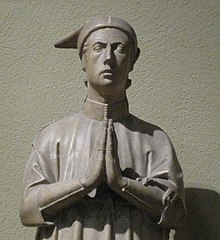
Padua is a city and comune in Veneto, northern Italy. Padua is on the river Bacchiglione, west of Venice. It is the capital of the province of Padua. It is also the economic and communications hub of the area. Padua's population is 214,000. The city is sometimes included, with Venice and Treviso, in the Padua-Treviso-Venice Metropolitan Area (PATREVE) which has a population of around 2,600,000.

Andrea Mantegna was an Italian painter, a student of Roman archeology, and son-in-law of Jacopo Bellini.
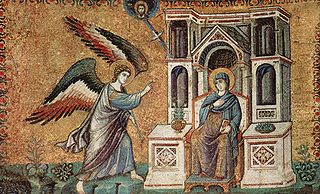
Pietro Cavallini was an Italian painter and mosaic designer working during the late Middle Ages.

Vincenzo Scamozzi was an Italian architect and a writer on architecture, active mainly in Vicenza and Republic of Venice area in the second half of the 16th century. He was perhaps the most important figure there between Andrea Palladio, whose unfinished projects he inherited at Palladio's death in 1580, and Baldassarre Longhena, Scamozzi's only pupil.

The Basilica di Santa Croce is a minor basilica and the principal Franciscan church of Florence, Italy. It is situated on the Piazza di Santa Croce, about 800 meters south-east of the Duomo, on what was once marshland beyond the city walls. Being the burial place of some of the most illustrious Italians, such as Michelangelo, Galileo, Machiavelli, the poet Foscolo, the philosopher Gentile and the composer Rossini, it is also known as the Temple of the Italian Glories.

Altichiero da Zevio, also called Aldighieri da Zevio, was an Italian painter much influenced by Giotto, certainly through knowledge of the frescoes in the Cappella degli Scrovegni in Padua and quite possibly through having been trained in Florence by one of Giotto's pupils. Altichiero worked in Verona and Padua. Works by him survive in the church of Sant'Anastasia in Verona and in the Cappella di S Felice in the basilica of Sant'Antonio and the Oratorio di San Giorgio in Padua. His stature was compromised for a long time through his supposed collaboration with a certain Jacopo Avanzo or Avanzi, but study of the documents and historiography demonstrated Atichiero's authorship of the frescoes in both the Santo and the Oratorio di San Giorgio. It has been argued that the hand of an assistant can be seen in some early scenes in the Santo – although it was certainly Altichiero who was paid to decorate the chapel, and he received 792 ducats in the summer of 1379.
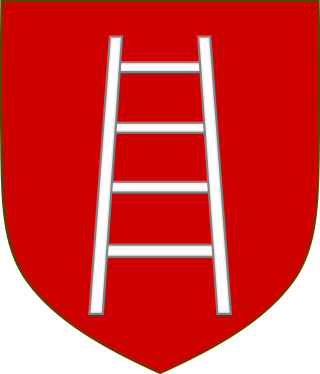
The House of Della Scala, whose members were known as Scaligeri or Scaligers, was the ruling family of Verona and mainland Veneto from 1262 to 1387, for a total of 125 years.

The Scrovegni Chapel, also known as the Arena Chapel, is a small church, adjacent to the Augustinian monastery, the Monastero degli Eremitani in Padua, region of Veneto, Italy. The chapel and monastery are now part of the complex of the Musei Civici di Padova.
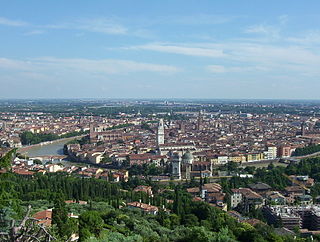
Events in the history of Verona, in Italy.
Reginaldo degli Scrovegni was a Paduan nobleman of the Guelph faction who lived in the early 14th century around the time of Giotto and Dante. He is best known for being a wicked usurer, and by association with his son, Enrico degli Scrovegni, who commissioned the famous Arena Chapel by Giotto.

Italian Renaissance painting is the painting of the period beginning in the late 13th century and flourishing from the early 15th to late 16th centuries, occurring in the Italian Peninsula, which was at that time divided into many political states, some independent but others controlled by external powers. The painters of Renaissance Italy, although often attached to particular courts and with loyalties to particular towns, nonetheless wandered the length and breadth of Italy, often occupying a diplomatic status and disseminating artistic and philosophical ideas.

The Church of the Eremitani, or Church of the Hermits, is a former-Augustinian, 13th-century Gothic-style church in Padua, region of the Veneto, Italy. It is also now notable for being adjacent to the Cappella Scrovegni with Giotto frescoes and the municipal archeology and art gallery: the Musei Civici agli Eremitani, which is housed in the former Augustinian monastery located to the left of the entrance.

Lamentation (The Mourning of Christ) is a fresco painted c.1305 by the Italian artist Giotto as part of his cycle of the Life of Christ on the interior walls of the Scrovegni Chapel in Padua, Italy.
Giuliano Pisani is a writer, classical philologist, scholar of ancient Greek and Latin literature, and art historian who was born on April 13, 1950, in Verona, Italy. He graduated with a degree in ancient Greek history from Padua University with Professor Franco Sartori. He was a full professor of Greek and Latin literature at Liceo Tito Livio in Padua. Since 2011, he has been a member of the National Italian Committee of the Promoters of Classical Culture at MIUR. He was also the technical coordinator of the first Olympiad in Classical Languages and Civilizations, which was held in Venice.
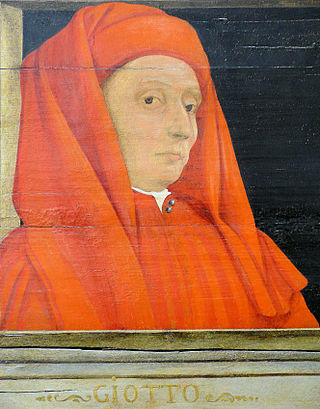
Giotto di Bondone, known mononymously as Giotto and Latinised as Giottus, was an Italian painter and architect from Florence during the Late Middle Ages. He worked during the Gothic/Proto-Renaissance period. Giotto's contemporary, the banker and chronicler Giovanni Villani, wrote that Giotto was "the most sovereign master of painting in his time, who drew all his figures and their postures according to nature" and of his publicly recognized "talent and excellence". Giorgio Vasari described Giotto as making a decisive break with the prevalent Byzantine style and as initiating "the great art of painting as we know it today, introducing the technique of drawing accurately from life, which had been neglected for more than two hundred years".

Carlo Naya was an Italian photographer known for his pictures of Venice including its works of art and views of the city for a collaborative volume in 1866. He also documented the restoration of Giotto's frescoes at the Scrovegni Chapel in Padua.
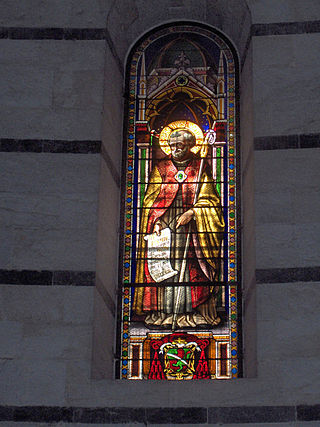
Guglielmo Botti was an Italian dresser and restorer.
The following is a timeline of the history of the city of Padua in the Veneto region of Italy.

The Padua Crucifix is a painting of c. 1303–1305 in tempera on poplar panel by Giotto. Originally hanging in the centre of the Scrovegni Chapel in Padua, above the latticework of the iconostasis, it was probably contemporaneous with his frescoes in the same chapel. It now hangs in the Musei degli Eremitani in Padua.

The Crucifixion is a painting in tempera and gold on panel of c. 1315 attributed to Giotto, now in the Musée des Beaux-Arts of Strasbourg, France.
